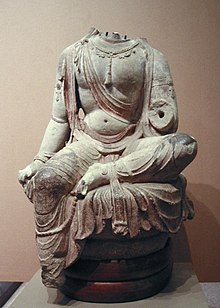This is an old revision of this page, as edited by Benjwong (talk | contribs) at 05:44, 3 August 2007. The present address (URL) is a permanent link to this revision, which may differ significantly from the current revision.
Revision as of 05:44, 3 August 2007 by Benjwong (talk | contribs)(diff) ← Previous revision | Latest revision (diff) | Newer revision → (diff)
The Four Olds or the Four Old Things (simplified Chinese: 四旧; traditional Chinese: 四舊; pinyin: sì jiù) were Old Custom, Old Culture, Old Habits, and Old Ideas. One of the stated goals of the Cultural Revolution in the People's Republic of China was to bring an end to the Four Olds. It started in Beijing on August 20, 1964.
Names
A number of names have been used to describe the series of campaigns.
- Anti-Four Olds
- Smash the Four Olds
- Destruction of the Four Olds
Campaign
Guidelines
The Communist Party of China set very loose guidelines in terms of classifying what is actually "old". As a result, anything before 1949 were destroyable. Anyone caught having possession of "old goods" would suffer serious consequences from the Red Guards.
Destruction
Mao Zedong called for the Four Olds to be swept away at the very early stages of the Cultural Revolution in 1964. Red Guards listened tentatively to Mao’s call. As a result Chinese architecture were ransacked, Chinese literature and classics were burned, Chinese paintings were torn apart, antiquities were shattered. People in possession of these goods were punished. Intellectuals were targeted as personifications of the Four Olds, and sometimes they were mocked, harassed, imprisoned, tortured, or killed.
Upon learning that the Red Guard was approaching the Forbidden City, Premier Zhou Enlai ordered the gates shut and troops posted, knowing of the Red Guard's reputation of destroying cultural objects.
Popular slogans
- “breaking down the four olds, setting up the four news”
- “beating down the bad elements”
- “beating down imperialism”
- “beating down foreign religion”
- “beating down Jesus following”
- “beating down the counter revolutionists”
Communist Party response
No actual statistics has ever been made by the party in terms of reporting the actual cost of damage. By 1978 many of the facts resurfaced through stories, and the event became alarming.
Restoration
Starting in the 1990's and continuing into the 21st century, there has been a massive rebuilding effort underway to restore and rebuild cultural sites that were destroyed or damaged during the Cultural Revolution. Though a serious number of sources have already pointed to the fakes and replicas created to generate wealth. Including major websites such as ebay and others demonstrating ways to spot hoax ceramics and other cultural items.
See also
References
- Spence, Jonathan. The Search for Modern China. 2nd ed. New York: W.W. Norton & Co., 1999. p575
- ^ Law, Kam-yee. (2003). The Chinese Cultural Revolution Reconsidered: beyond purge and Holocaust. ISBN 0333738357
- Lo, Ruth Earnshaw. Kinderman, Katharine S. (1980). In the Eye of the Typhoon. Harcourt Brace Jovanovich publishing. University of michigan Digitized no ISBN Apr 10, 2006
- Perry, Link. (1993). Evening Chats in Beijing. W.W. Norton & Company. ISBN 0393310655
- Lu, Tonglin. (2002). Confronting Modernity in Cinemas of Taiwan and Mainland China. ISBN 0521806771
- ^ Wen, Chihua. Madsen, Richard P. (1995). The Red Mirror: Children of China's Cultural Revolution. Westview Press. ISBN 0813324882
- Boxun.com zongjiaoxinyang
- Roberts, Richard H. (1995). Religion and the Transformations of Capitalism. Routledge publishing. ISBN 0415119170
- Chinafraud